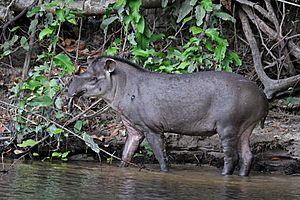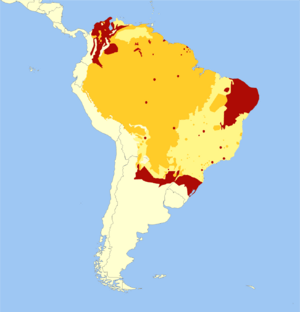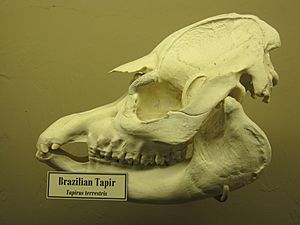South American tapir facts for kids
Quick facts for kids South American tapir |
|
|---|---|
 |
|
| Cristalino River, Brazil | |
| Conservation status | |
| Scientific classification | |
| Genus: |
Tapirus
|
| Species: |
terrestris
|
 |
|
| South American tapir distribution Extinct Extant Probably extant |
|
The South American tapir (Tapirus terrestris) is also known by many other names. Some of these are the Brazilian tapir, Amazonian tapir, maned tapir, or lowland tapir. In Portuguese, it's called anta, and in a mix of Quechua and Spanish, it's sachavaca (which means "bushcow").
This animal is one of four main types of tapirs. The other three are the mountain tapir, the Malayan tapir, and Baird's tapir. The South American tapir is the biggest native land mammal living in the Amazon today.
Contents
What Does the South American Tapir Look Like?
The South American tapir has dark brown fur. Its face is a bit lighter in color. It has a short, stiff mane that runs from its head down its neck. Its ears are round and dark, with clear white edges.
Baby tapirs are born with a dark brown coat. They have small white spots and stripes all over their bodies. An adult South American tapir can be about 1.8 to 2.5 meters (about 6 to 8 feet) long. It has a short, stubby tail, only about 5 to 10 centimeters (2 to 4 inches) long. On average, an adult weighs around 225 kilograms (about 496 pounds). They stand about 77 to 108 centimeters (30 to 43 inches) tall at the shoulder.
Where Do South American Tapirs Live?
You can find the South American tapir near water in the Amazon Rainforest and River Basin. This area is in South America, to the east of the Andes mountains.
Their home range stretches from countries like Venezuela, Colombia, and the Guianas in the north. It goes down to Brazil, Argentina, and Paraguay in the south. To the west, it includes Bolivia, Peru, and Ecuador. Sometimes, a tapir might swim across the sea channel from Venezuela to the island of Trinidad. However, they do not have a breeding population there.
South American Tapir Behavior
South American tapirs are excellent swimmers and divers. They can also move very quickly on land, even on rough, hilly ground. These animals usually live for about 25 to 30 years.
In the wild, large predators hunt tapirs. These include big crocodiles like the black caiman and the Orinoco crocodile. Large cats, such as the jaguar and cougar, also hunt them. These cats often attack tapirs at night when the tapirs leave the water to sleep on the riverbank. The green anaconda can also attack South American tapirs. When a tapir gets scared, it is known to run into the water to hide.
Scientists are still studying how these tapirs interact with each other. More research is needed to understand their social lives better.
What Do South American Tapirs Eat?
The South American tapir is an herbivore, which means it only eats plants. It uses its flexible nose to find food. It eats leaves, buds, new shoots, and small branches that it pulls from trees. They also enjoy fruits, grasses, and plants that grow in water. Tapirs also eat many of the seeds found in the rainforest.
Scientists learn about their diet by watching them eat. They also study their droppings and the contents of their stomachs.
Reproduction and Life Cycle
Female tapirs are pregnant for about 13 months (390–395 days). They usually have one baby every two years. A newborn South American tapir weighs around 6.8 kilograms (about 15 pounds). The baby tapir will drink its mother's milk for about six months.
Why Are South American Tapirs Endangered?
The number of South American tapirs is decreasing. This is mainly because people hunt them for their meat and hides. Their homes are also being destroyed.
The South American tapir is generally seen as an endangered animal species. The United States Fish and Wildlife Service officially listed it as endangered on June 2, 1970. However, it is at a lower risk of extinction compared to the other four tapir species.
Gallery
See also
 In Spanish: Tapir amazónico para niños
In Spanish: Tapir amazónico para niños









